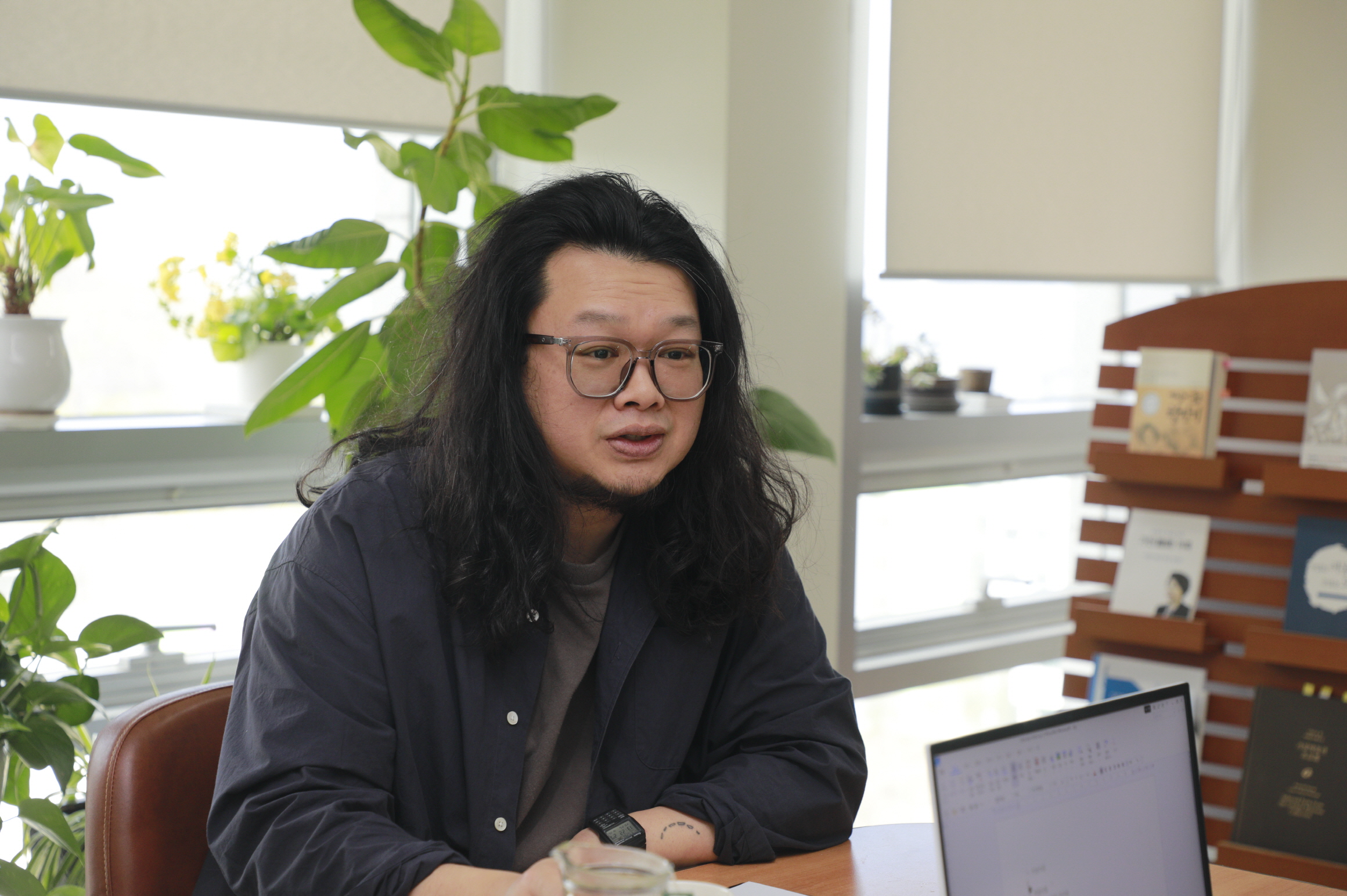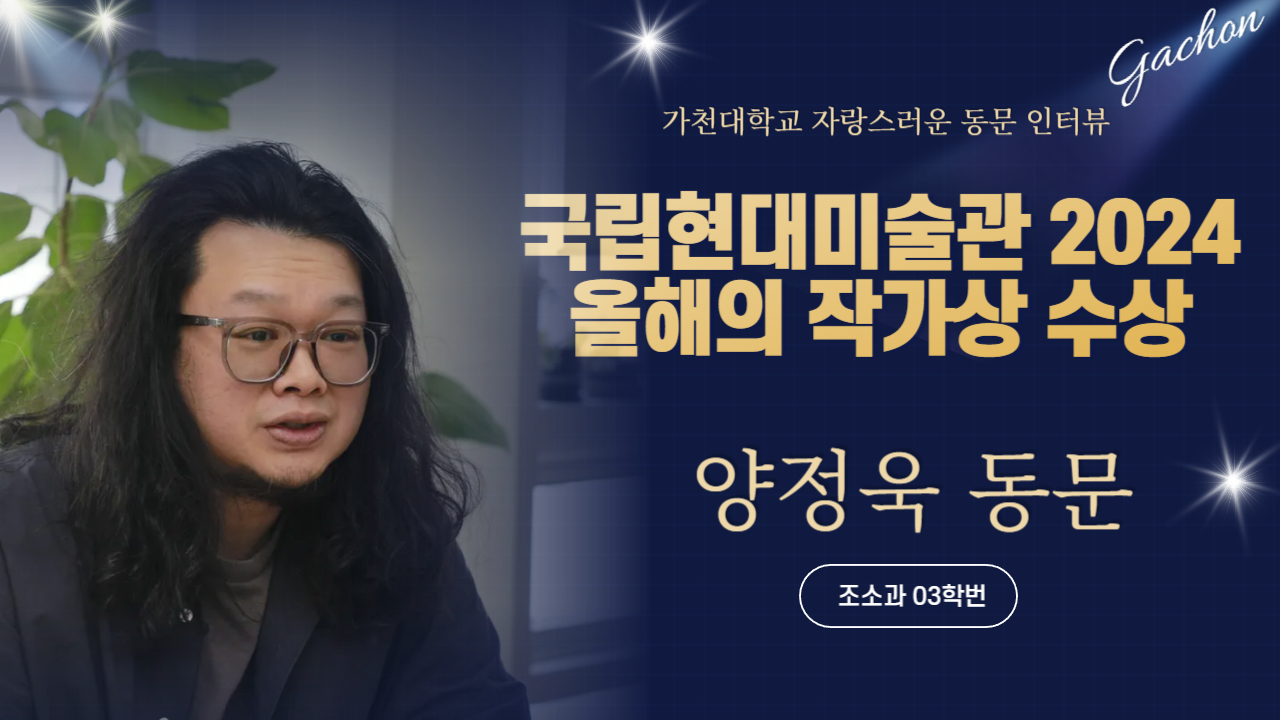- 글번호
- 110166
Gachon University alumnus Yang Jung-uk (Class of 2003, Department of Sculpture) has been awarded the National Museum of Modern and Contemporary Art’s 2024 Artist of the Year Award.
- 수정일
- 2025.05.27
- writer
- 정보인프라팀
- count
- 156
- date
- 2025.05.27
Gachon University Proud Alumni Interview
Praised as “a work that once again reminds us of art’s power to bring comfort,” among other positive reviews

Gachon University alumnus Yang Jung-uk has been awarded the National Museum of Modern and Contemporary Art’s 2024 Artist of the Year Award.
Yang Jung-uk, a Gachon University alumnus from the Department of Sculpture (Class of 2003), was selected in February as the final recipient of the National Museum of Modern and Contemporary Art’s 2024 Artist of the Year Award, jointly hosted with the SBS Culture Foundation. This award recognizes the leading figure in the art world for the year.
The “Artist of the Year Award” annually selects four talented visual artists, providing them with opportunities to create new works and exhibit them. Among these, one artist is chosen as the final winner. Each nominated artist receives a creative grant of 50 million won, and the final awardee is granted an additional 10 million won.
Yang Jung-uk’s work received high praise from the judging panel, including comments such as “a piece that once again reminds us of art’s power to bring comfort” (Kim Hae-joo, Senior Curator at Singapore Art Museum) and “it is moving how the large-scale works and the humble pieces made from leftover materials after the creation process connect and interact” (Charles Landbrouet, Head of Research at the Stedelijk Museum Amsterdam, Netherlands).
At the nominee exhibition held at the National Museum of Modern and Contemporary Art Seoul, Yang presented works including In a Field of the Familiar Yet Unknown (2024), Hearts That Care for Each Other (2024), Technology Comes from Devotion, Temporary Map (2024), and The Drawing of One Who Wishes to Remember (2024).
After receiving the award, Yang returned to his alma mater on the 15th to give a special lecture for junior students despite his busy schedule. An interview was conducted with him at the university’s PR office, where he shared his thoughts on the award.
Interview Highlights
Q. Congratulations on winning the 2024 Artist of the Year Award. Please share your thoughts on receiving this honor.
→ The National Museum of Modern and Contemporary Art’s “Artist of the Year” award was established when I graduated from university. It is one of the highest honors in the Korean art world, on par with the National Art Exhibition (Gukjeon), so I had long aimed to receive it at least once.
This award is both a personal honor and a recognition of the artistic trajectory I’ve built since graduation, as well as my response to new directions demanded by the art world. Seeing my work being understood and appreciated by both the art community and the public through this award gave me renewed motivation. I feel I’ve achieved a major goal as an artist.
Q. How did your time at Gachon University’s Department of Sculpture influence you as an artist?
→ When I entered, Gachon’s art entrance exam had no standardized format, which allowed for a unique and flexible artistic approach. The school looked at me beyond conventional entrance art styles, which was also well known among private academies.
Though I majored in sculpture, I also took painting classes to develop my sensibility as a painter and began seriously focusing on sculpture after admission. I won awards in university-hosted art competitions, receiving benefits as an art-specialized student. From my second year, I participated in the then-popular “Ssamzie Space” exhibitions and took classes with artist Ham Jin, a fellow Gachon alumnus and Venice Biennale invitee, gaining diverse artistic inspiration.
At that time, Gachon’s art college was nicknamed the “barbarian university.” While Hongik University held the “shield and sword,” we were recognized for our original and creative style like a “bent trident,” which gave students great pride.
Many renowned artists also graduated from Gachon. These experiences laid an important foundation for my artistic direction and independence.
Q. What was the most difficult moment starting out as an artist, and how did you overcome it?
→ I studied for seven years, repeatedly taking leaves of absence and returning due to financial difficulties while juggling part-time jobs. Professor Kim Yoo-sun understood my situation and personally supported me with scholarships and living expenses. Even after receiving that help, I was so desperate I couldn’t return to school immediately. Later, I saved money to repay the professor, but she refused to accept it except for tuition. I have never forgotten that kindness and now try to support young artists myself.
Right after graduation, it was hard to make a living from exhibitions, especially with installation and large-scale works. To support myself, I worked as a director at a design company and ran a craft business alongside my art. When struggling, I often visited my alma mater’s campus to reflect and sought advice from juniors working late nights.
Q. Your moving sculptures convey stories of life. Could you tell us about your philosophy of art?
→ My work starts with “people” and “the heart.” People are beings moved by the heart, which in turn moves others and changes the world. Machines run on electricity, but humans act on the heart, and the output is different. Visualizing emotional waves and the energy of the heart is central to my work. I believe I received the Artist of the Year award because, in this era, the movement of the heart and small human stories have become key themes.
Q. Your works communicate comfort and connection. Where do you find inspiration for these themes?
→ I’ve always been interested in emotional exchange. I see art as a medium that visually captures and shares moments of emotion. From my first year, I pondered questions like “Where is the wrist?” and delved into the essence of things, which evolved into a philosophical reflection on vocation and influenced later series. I’ve sought the essence of emotion within small, subtle feelings and adhesive-like relationships.
Q. Your work titles, such as In a Field of the Familiar Yet Unknown and Technology Comes from Devotion, are very unique. How do you choose them?
→ I believe titles must be short but convey a strong message. After putting my child to sleep, I sometimes spend 1-2 hours focused on writing or titling. Titles should stick in people’s memories like advertising copy. Writing is occasionally my main occupation because the title is the “cover” that best explains my work. Since grabbing the audience’s attention is crucial, I put great care into naming.
Q. What are your future creative plans or projects you want to challenge?
→ I am preparing a series about mothers. Raising a child has made me deeply appreciate the greatness of mothers as creators and nurturers, and I want to express that in my work.
Q. What message would you like to share with Gachon University’s College of Arts students and young artists?
→ The AI era is an era of opportunity for artists. If you can showcase the uniqueness of your creativity, emotion, and tactile skills, you can definitely get noticed. I encourage students to visit libraries and study magazines from the past five years to learn about trends in architecture, advertising, real estate, etc. At school, it’s important not just to learn but to absorb and awaken to new insights. When lost or struggling, following the paths of seniors can help you explore your own way.
Art is romantic, but realization requires thorough calculation and execution. How you spend each day and how efficiently matters. Artists must grow not only through imagination but also through realistic planning. Calculate your daily productivity and keep your mind active even on the way to school. From the moment you enter the gate, the work has already begun. I’m very proud to be a Gachon University art graduate, and our university is gaining recognition in the domestic and international art scenes. Don’t forget this, and I support your future as artists.
Thank you.





